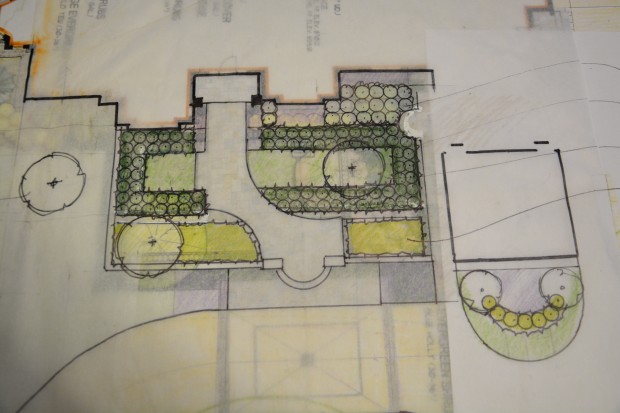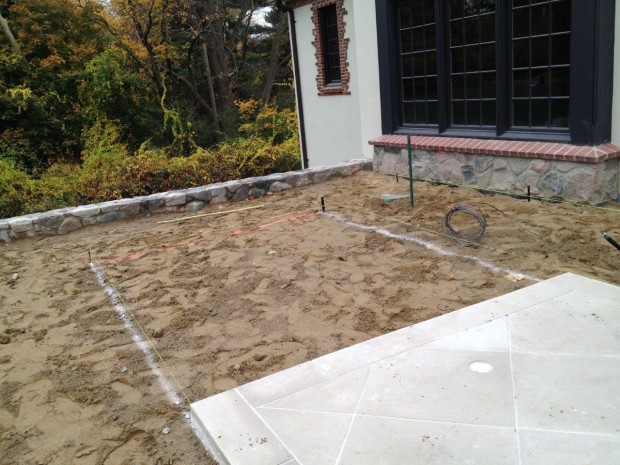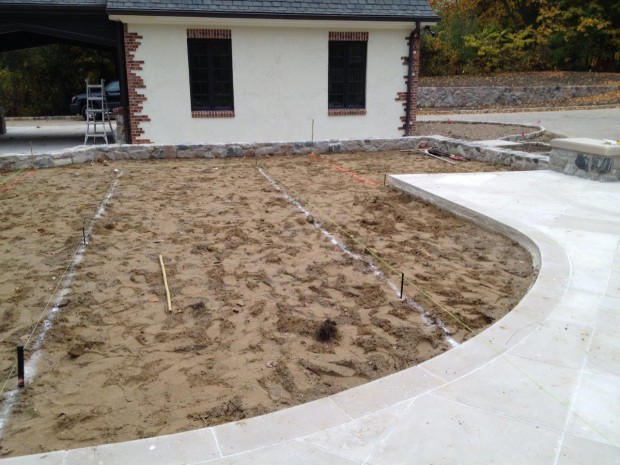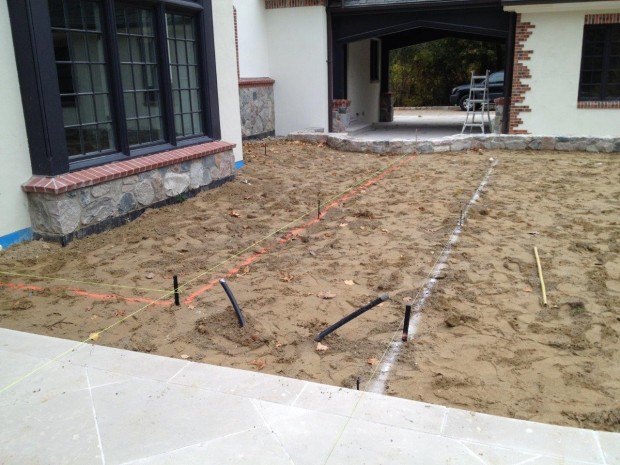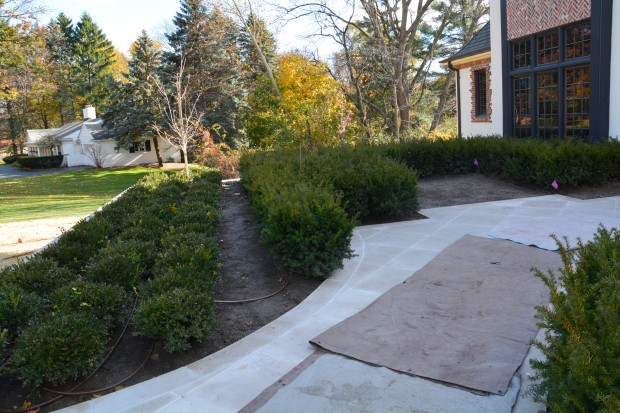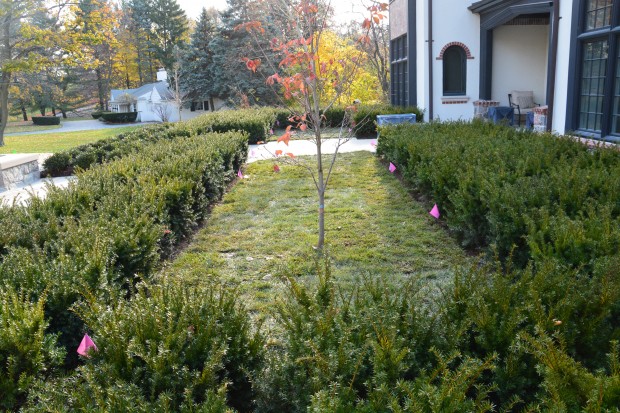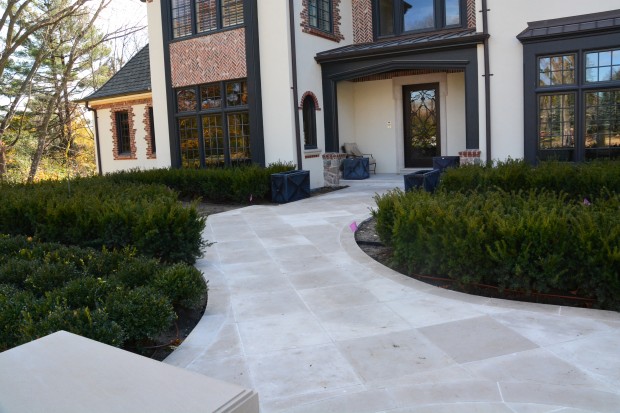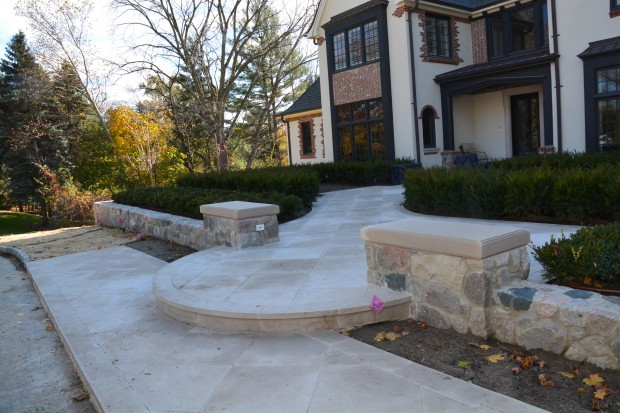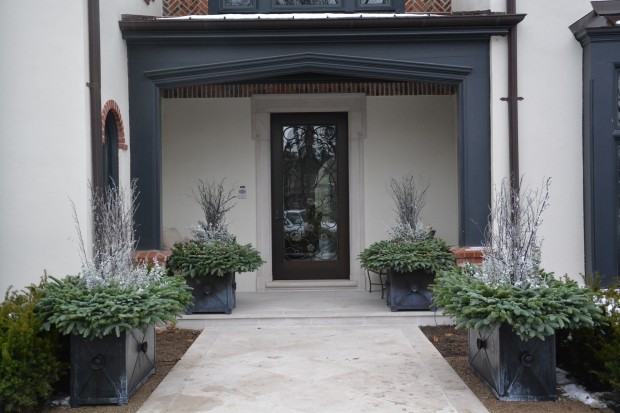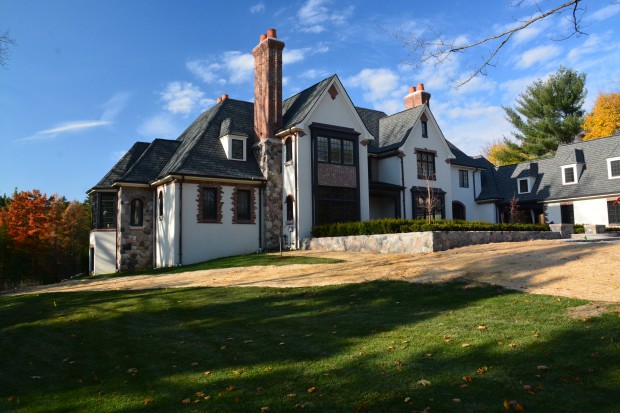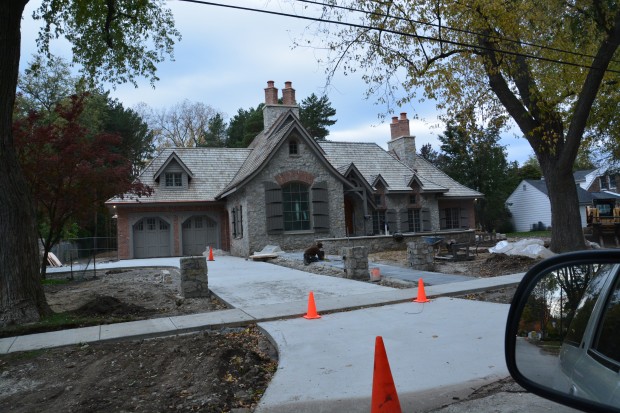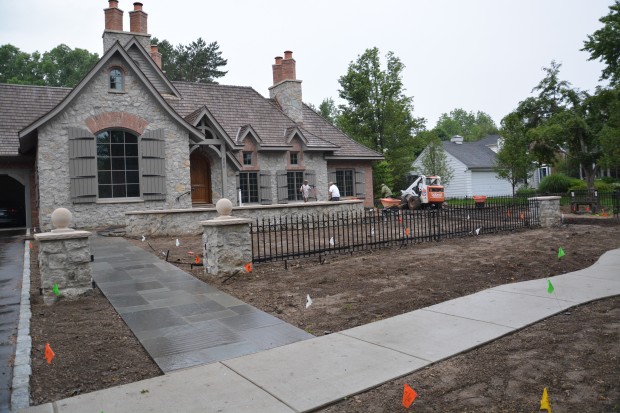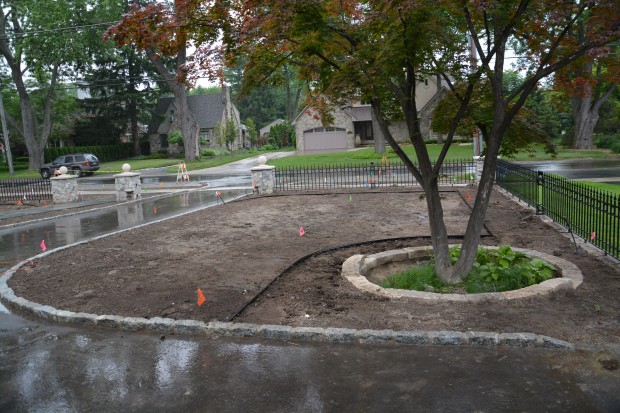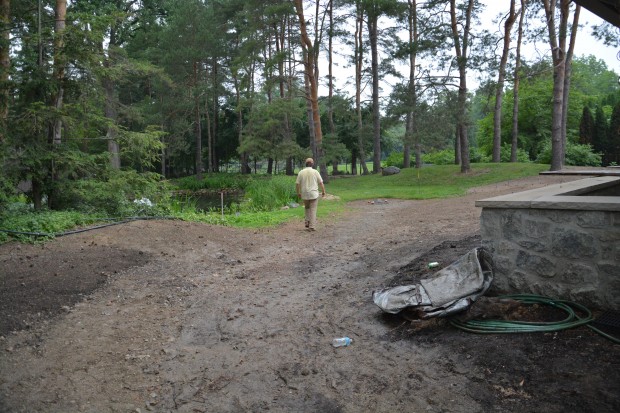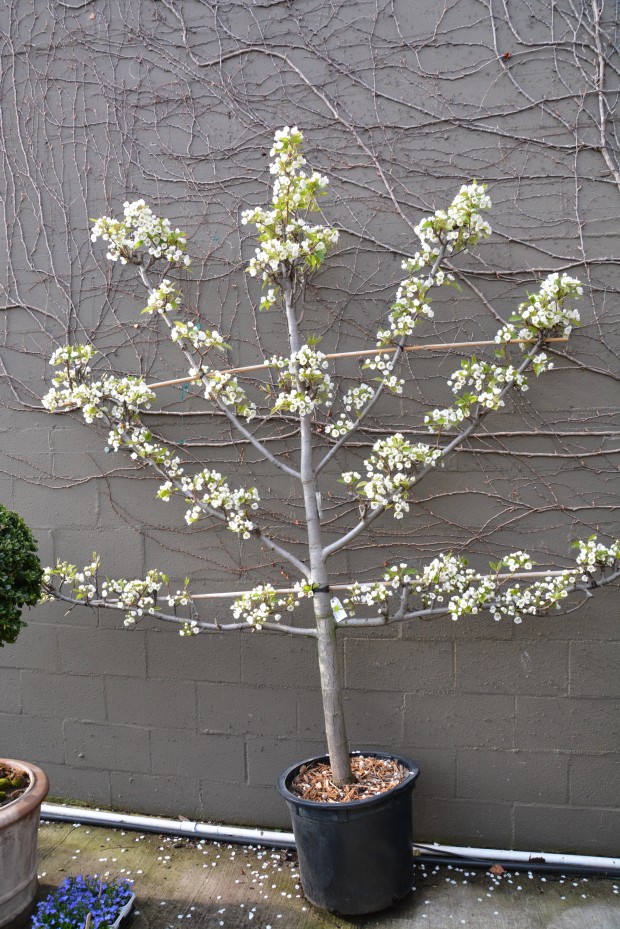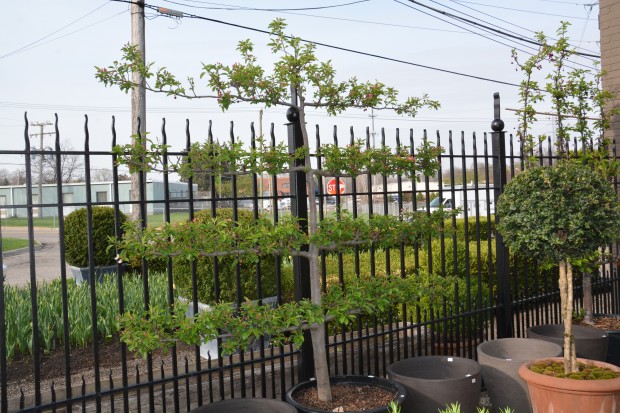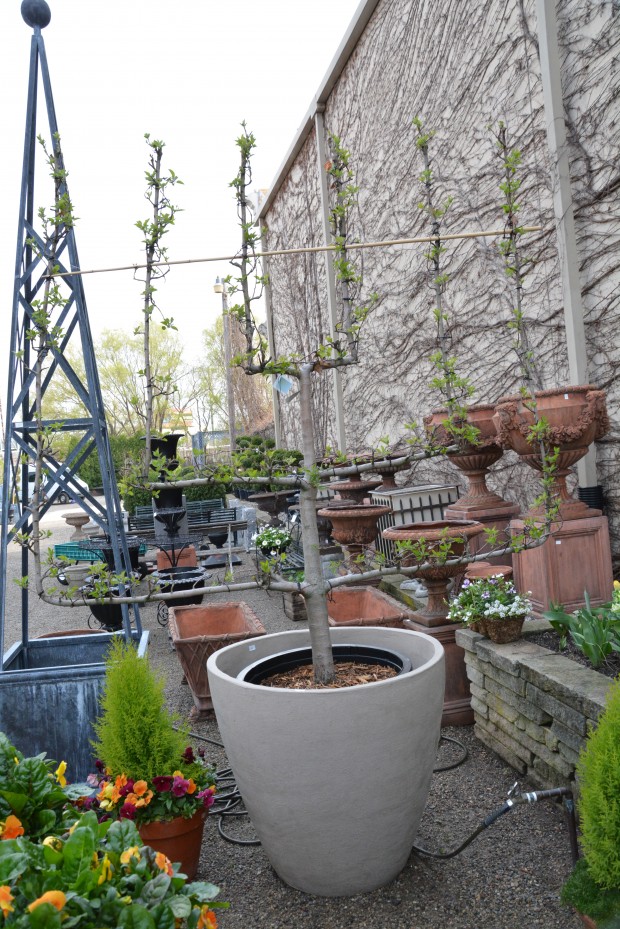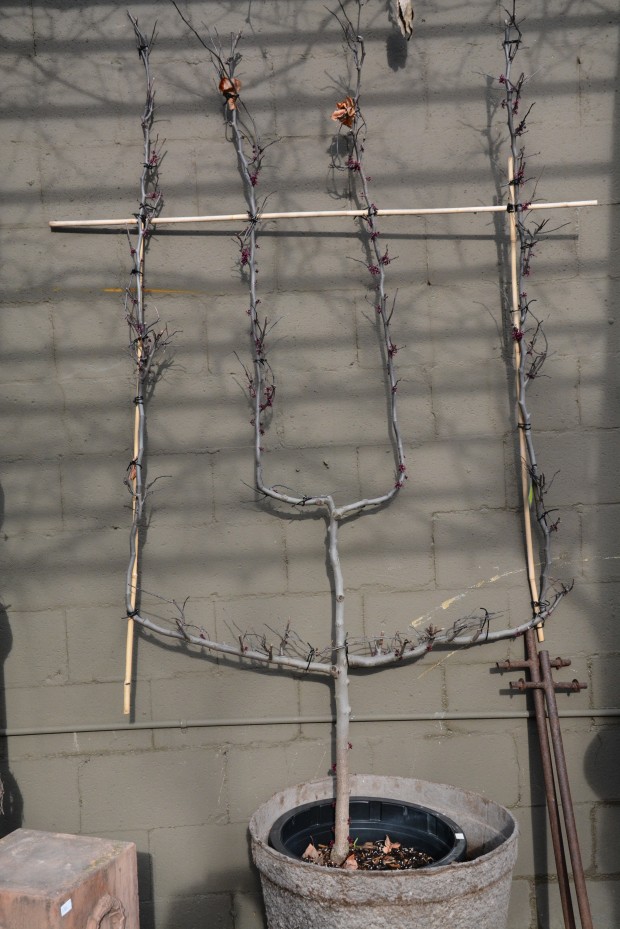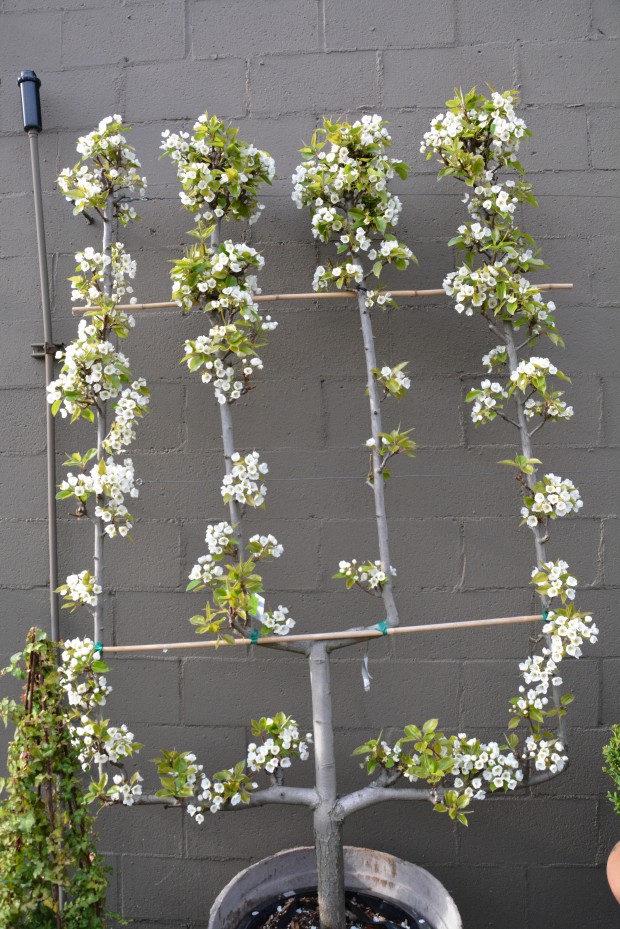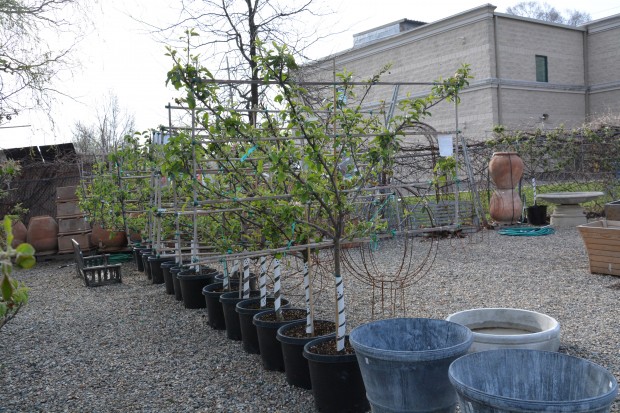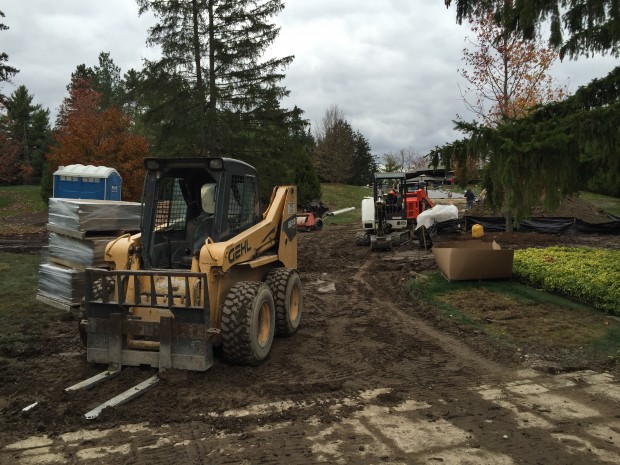 Every landscape project presents its own particular set of challenges. In the ordinary course of events, the planting of a landscape comes after the installation of the hard structures. A new house has to be designed, built, and close to a finish, before the landscape installation can begin. Hard structures in a landscape renovation refers to pergolas, gates, terraces, arbors, sidewalks, underground electrical conduit for landscape lighting, air conditioners and generators, and the driveway. Our current project is a perfect storm of related but separate renovation work on the outside, all going on at the same time. The concurrent installation of a new driveway, and our landscape installation, has been an experience like no other – just ask my landscape superintendent, Dan. I have designed plenty of driveways, both simple and complex, but I have never had to work on a landscape without one. This driveway is being installed in sections. A section gets removed, a new base is put down, and the new driveway is installed. All of the asphalt debris, and countless machines were on site. We have been scrambling for several weeks to get the big trees installed in those short and intermittent slots between the old driveway removal and the new driveway install. As you can see, there is no clear path from the road to the landscape we are installing at the top of the hill.
Every landscape project presents its own particular set of challenges. In the ordinary course of events, the planting of a landscape comes after the installation of the hard structures. A new house has to be designed, built, and close to a finish, before the landscape installation can begin. Hard structures in a landscape renovation refers to pergolas, gates, terraces, arbors, sidewalks, underground electrical conduit for landscape lighting, air conditioners and generators, and the driveway. Our current project is a perfect storm of related but separate renovation work on the outside, all going on at the same time. The concurrent installation of a new driveway, and our landscape installation, has been an experience like no other – just ask my landscape superintendent, Dan. I have designed plenty of driveways, both simple and complex, but I have never had to work on a landscape without one. This driveway is being installed in sections. A section gets removed, a new base is put down, and the new driveway is installed. All of the asphalt debris, and countless machines were on site. We have been scrambling for several weeks to get the big trees installed in those short and intermittent slots between the old driveway removal and the new driveway install. As you can see, there is no clear path from the road to the landscape we are installing at the top of the hill.
 33 pinus flexilis hybrid pine trees, 9 feet tall and better, with 36″ diameter rootballs, got delivered curbside this morning. We could not truck them to the spot where they will be planted. The new sections of driveway are not ready for traffic, and the rest of the old drive is gone. We had already cleared the old failing plants from the area for these new trees, one wheelbarrow load at a time. My client came to the rescue. She arranged for the driveway contractor to bring an electric power jack to the site, and provide 3 people in addition to our 6 to get those big trees uphill. Soulliere Stone Design, owned by Tim Soulliere, is in charge of installing the new driveway. Removing the old drive, widening the new drive by 40″, installing a drive of concrete pavers and curbing piece by piece, is a big job which is turning out to be a beautiful job. But today he suspended his work, and gave us a huge hand.
33 pinus flexilis hybrid pine trees, 9 feet tall and better, with 36″ diameter rootballs, got delivered curbside this morning. We could not truck them to the spot where they will be planted. The new sections of driveway are not ready for traffic, and the rest of the old drive is gone. We had already cleared the old failing plants from the area for these new trees, one wheelbarrow load at a time. My client came to the rescue. She arranged for the driveway contractor to bring an electric power jack to the site, and provide 3 people in addition to our 6 to get those big trees uphill. Soulliere Stone Design, owned by Tim Soulliere, is in charge of installing the new driveway. Removing the old drive, widening the new drive by 40″, installing a drive of concrete pavers and curbing piece by piece, is a big job which is turning out to be a beautiful job. But today he suspended his work, and gave us a huge hand.
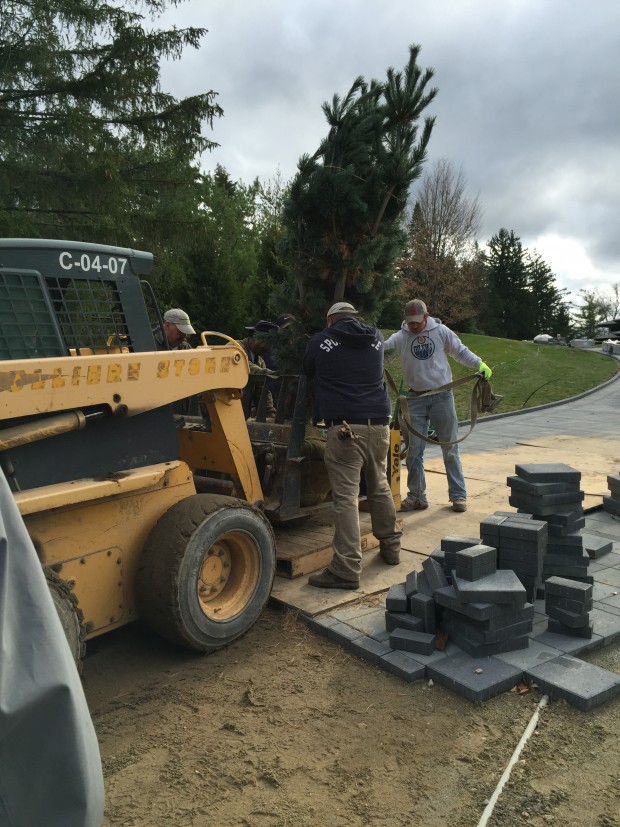 The bad news? We could only move one tree at a time. The good news? We were not pushing each tree up a fairly steep slope by hand. The newest portions of the drive had not yet been sanded. Polymeric sand is swept into the spaces between each paver, locking them together. In its current unfinished state, the drive could tolerate the pallet jack used by the paving crew move pallets of pavers to the spot where they are needed. Given the steady, sure, and thoughtful hand of a client, the driveway crew and the landscape crew came together to get a job done. The front and newest section of the new driveway was protected by sheets of plywood.
The bad news? We could only move one tree at a time. The good news? We were not pushing each tree up a fairly steep slope by hand. The newest portions of the drive had not yet been sanded. Polymeric sand is swept into the spaces between each paver, locking them together. In its current unfinished state, the drive could tolerate the pallet jack used by the paving crew move pallets of pavers to the spot where they are needed. Given the steady, sure, and thoughtful hand of a client, the driveway crew and the landscape crew came together to get a job done. The front and newest section of the new driveway was protected by sheets of plywood.
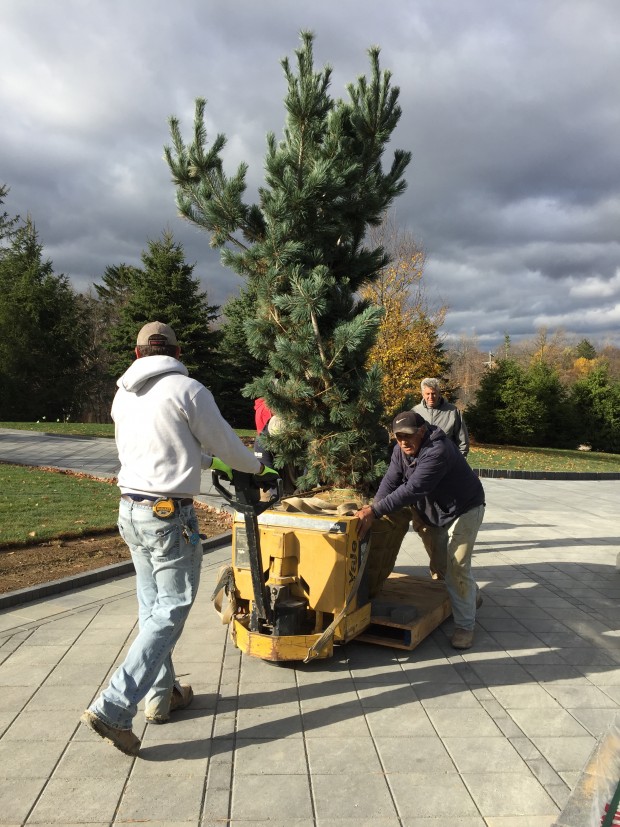 The parts of the driveway that had already been stiffened by the addition of polymeric sand took the trips up with one tree at a time effortlessly. However the effort expended by both crews was considerable. Despite the pulling power of the jack, there was concern that the battery would need recharging before the last of the trees were moved. They pushed. Every landscape project, whether large or small, asks for creating an order of events all aimed at the finish. In the event that the order of events is interrupted, cooperation makes a job move forward.
The parts of the driveway that had already been stiffened by the addition of polymeric sand took the trips up with one tree at a time effortlessly. However the effort expended by both crews was considerable. Despite the pulling power of the jack, there was concern that the battery would need recharging before the last of the trees were moved. They pushed. Every landscape project, whether large or small, asks for creating an order of events all aimed at the finish. In the event that the order of events is interrupted, cooperation makes a job move forward.
 These 33 trees are taking up a lot more space on the ground plane than they will when they are planted. My grower has had these pinus flexilis “Vanderwolf’s” in the ground for a good many years. They are incredibly beautiful plants. A group of 14 we will plant as a hedge. Pinus flexilis refers to their very flexible branches. We will be able to co-mingle branches from one tree to the next to make a solid and dense hedge where there is a need for screening.
These 33 trees are taking up a lot more space on the ground plane than they will when they are planted. My grower has had these pinus flexilis “Vanderwolf’s” in the ground for a good many years. They are incredibly beautiful plants. A group of 14 we will plant as a hedge. Pinus flexilis refers to their very flexible branches. We will be able to co-mingle branches from one tree to the next to make a solid and dense hedge where there is a need for screening. 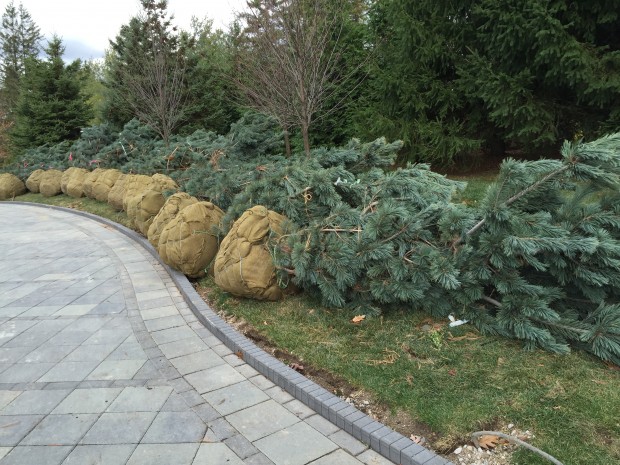 19 pinus flexilis “Joe Burke”, an irregular growing hybrid, will enable us to go around a number of old tree sized junipers. The junipers lowest branches are 7′ to 10′ off the ground. The ground level branches have been lost. Up high, the branches are beautiful, and swooping. The planting of the Joe Burkes will involve positioning one tree at a time, fitted to the previous tree, and in anticipation of the tree to come, in that irregular open space at ground level. They will have a loose and graceful habit. The wind off the lake will animate the branches. The blue color of the needles is a good companion with the juniper branches, and the color of the new driveway.
19 pinus flexilis “Joe Burke”, an irregular growing hybrid, will enable us to go around a number of old tree sized junipers. The junipers lowest branches are 7′ to 10′ off the ground. The ground level branches have been lost. Up high, the branches are beautiful, and swooping. The planting of the Joe Burkes will involve positioning one tree at a time, fitted to the previous tree, and in anticipation of the tree to come, in that irregular open space at ground level. They will have a loose and graceful habit. The wind off the lake will animate the branches. The blue color of the needles is a good companion with the juniper branches, and the color of the new driveway.
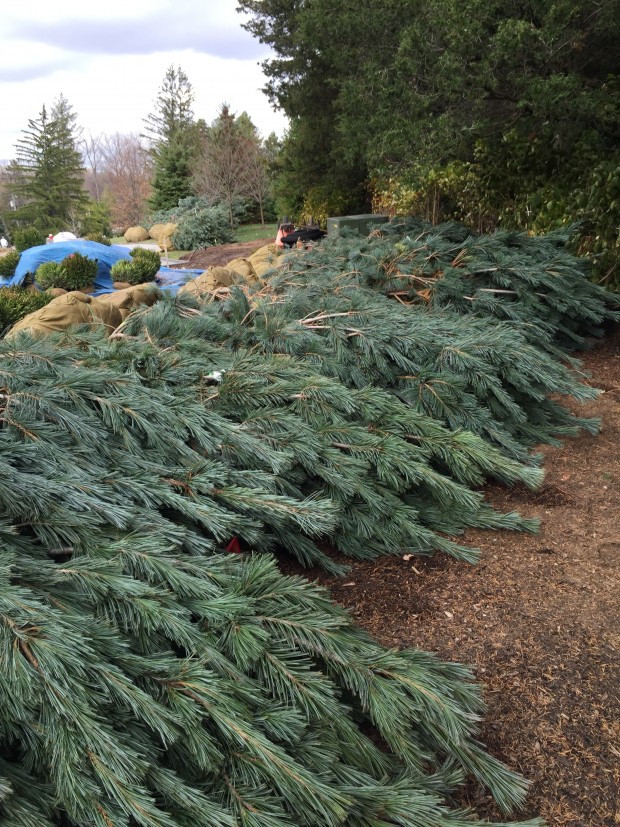 Pinus flexilis is on my short list of pines worth growing. Absent any pruning, they become open with age like other pines. But with judicious heading back in the spring, the Vanderwolf’s can be quite dense. They are slow growing, and adaptable. I will probably protect them from the wind coming off the lake for this first winter, to avoid burn to the needles. They are tolerant of partial shade, which is unusual for a pine. These will be sited with a western exposure, so it is important that they will thrive in less than a full day of sun. Each blue needle has a white stripe, which makes this tree stand out in the landscape.
Pinus flexilis is on my short list of pines worth growing. Absent any pruning, they become open with age like other pines. But with judicious heading back in the spring, the Vanderwolf’s can be quite dense. They are slow growing, and adaptable. I will probably protect them from the wind coming off the lake for this first winter, to avoid burn to the needles. They are tolerant of partial shade, which is unusual for a pine. These will be sited with a western exposure, so it is important that they will thrive in less than a full day of sun. Each blue needle has a white stripe, which makes this tree stand out in the landscape.
 I have a new landscape superintendent as of the past February. I am happy to report he is by far and away the best I have ever worked with. He is as knowledgeable about sound landscape practices as he is unflappable. This project is challenging, but he is easy going about working shoulder to shoulder with a whole raft of other tradespeople who are working on this project. He is confident in the outcome. It pleases me that despite his 30 years in the landscape business, he has never seen or planted a pinus flexilis. How easy it is to have an enduring and long standing interest in the natural world. There is always something new. This planting project will be a pleasure.
I have a new landscape superintendent as of the past February. I am happy to report he is by far and away the best I have ever worked with. He is as knowledgeable about sound landscape practices as he is unflappable. This project is challenging, but he is easy going about working shoulder to shoulder with a whole raft of other tradespeople who are working on this project. He is confident in the outcome. It pleases me that despite his 30 years in the landscape business, he has never seen or planted a pinus flexilis. How easy it is to have an enduring and long standing interest in the natural world. There is always something new. This planting project will be a pleasure.
